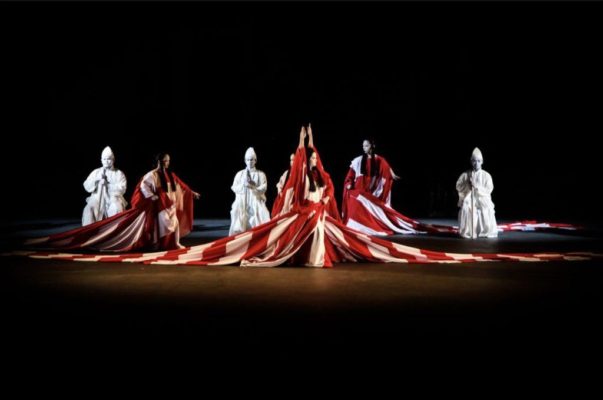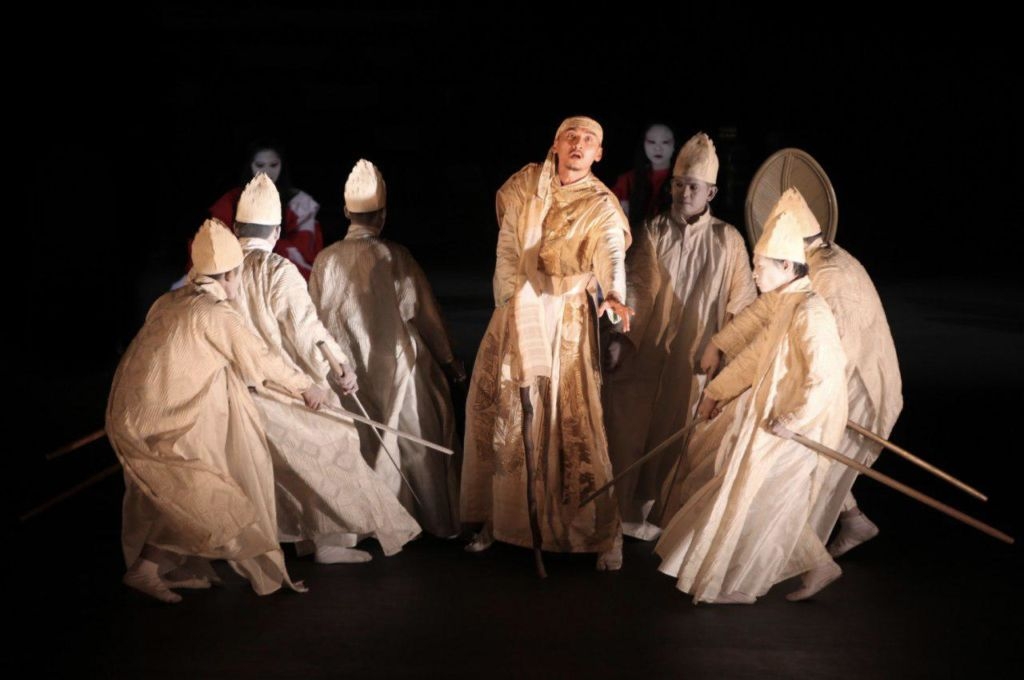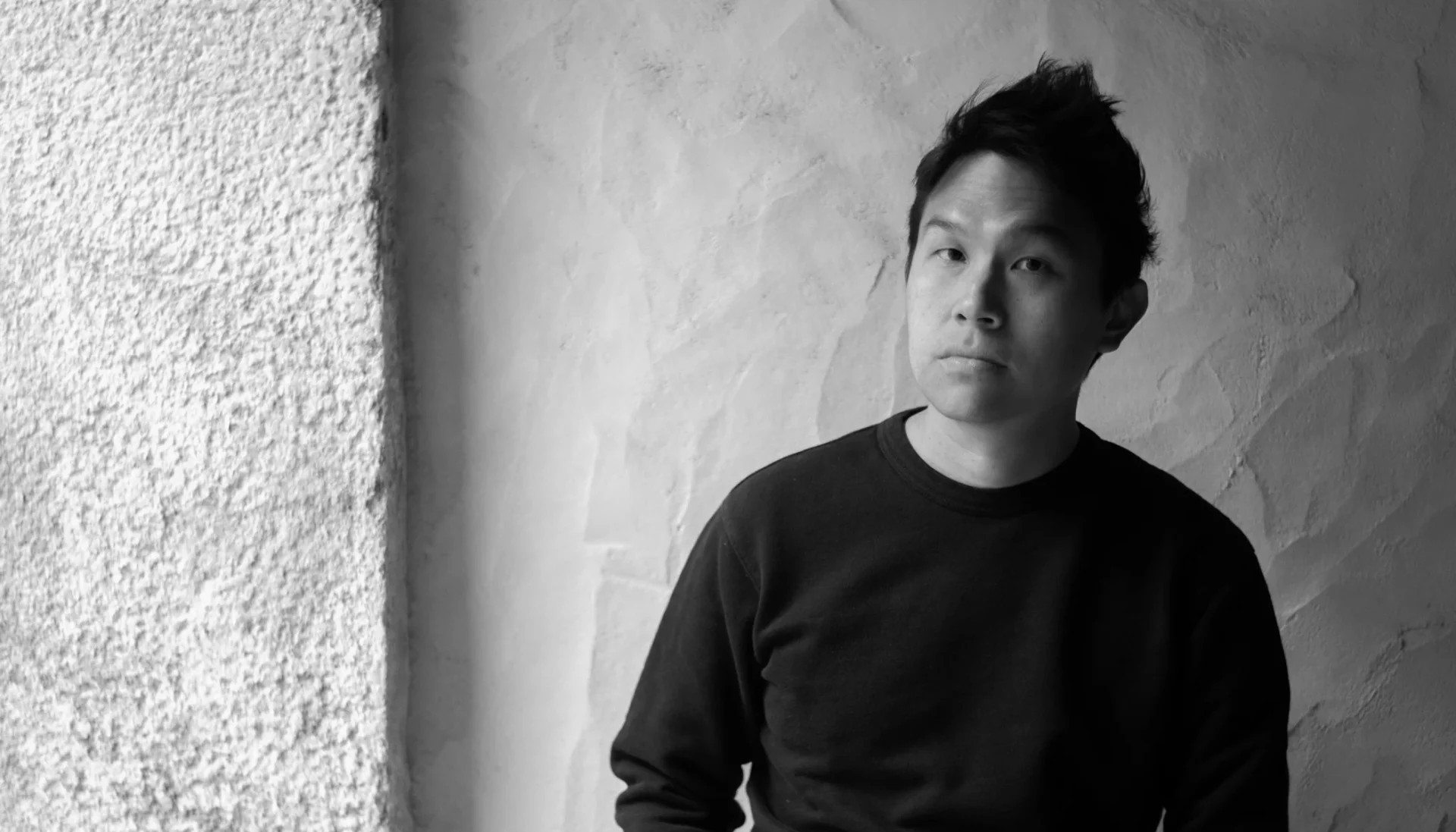Written by Cheryl Tan
In this special collaboration with art production house Purnati Indonesia, the interntaionally-acclaimed theatre director Tadashi Suzuki brings Euripides’ The Bacchae, adapted and retitled Dionysus, to life in this year’s Singapore International Festival of the Arts (SIFA).
Produced by Restu Imansari Kasumaningrun from Indonesia, Suzuki’s cross-cultural adaptation of this classic Greek tragedy features an impressive and diverse cast of Indonesian, Japanese and Chinese actors, offering our contemporary stage this ancient conflict of reason, method, and madness through an intriguing Pan-Asian angle.
Written near the end of Euripides’ life, The Bacchae has been hailed as one of the Athenian playwright’s greatest tragedies. Dionysus – the God of wine – unleashes his anger on and punishes Pentheus, King of Thebes, for blasphemous deeds such as denying Dionysus’s divinity. Madness ensues as the god Dionysus craftily lures Pentheus to his death by temptation and ridiculous reasoning. Pentheus follows Dionysus unknowingly, and is eventually torn to pieces by feverish worshippers, including his own mother Agave, who triumphantly thinks she has slaughtered a lion and does not recognise that she has murdered her own son. Upon learning this truth after some time, Agave is consumed by the deepest grief imaginable, and realises how the tales that the priests have weaved, about Dionysus and his power, has simply reduced both her and her son to mere mortal fools.
As I watched this adaptation, I found it important to remember that Euripides is ultimately shows us the power of storytelling, and how some tales, when constructed and construed in their most twisted ways, can make fools of us all. This is why, in Suzuki’s masterful adaptation, he successfully challenges the boundaries of storytelling by, most recognisably, inserting the presence of the god Dionysus into the speech and characters of an ensemble of priests. Nowhere is Dionysus — his spirit only speaks through his most ardent worshippers.
Donning the costume works of Indonesian designer Auguste Soesastro and Suzuki himself, the Bacchae (Sugiyanti Ariani, Hildawati, S. Dexara Hachika, D. Asti Wulanjani, Sarah Nurmala, and Kito Risa), emerged from the wings clothed in stunning lengths of striped, red and white robes. With precision and strength, they moved across the stage facing the audience at all times, pulling their trail of cloth behind them, wrapping and unwrapping themselves in it as they travelled the length of the stage at intervals dedicated to them. Their movements were accompanied by one of my favourite elements of the entire production — the drum-heavy, haunting music and sound design by Takada Midori.
The ensemble of priests (Ari Dwianto, Washadi, Mohamad Adita, Anwari A.A. Parah, Dian N. Saptura, and Seftino A. Sambalao) were clothed from head to toe in long white robes. Each holding a long staff, and together the cast truly carried the embodiment of divinity onstage. Each swift movement, perfectly synchronised, was weighted with authority and an urgent importance; each stillness made me wonder how many hours they had spent training to appear as lifeless as dolls. Even their hurried movements — fast-sliding walks — were unbelievably swift and smooth. There were several moments in which one might have assumed they had learnt to hover and glide quickly across the stage, if not for their feet, covered in white socks, displaying the excellent and disciplined footwork that so dominates the Suzuki method of actor training.
Besides the wonder of how the Suzuki method of actor training is employed so deftly in this production, I would also like to discuss the importance of the variety of spoken languages used in the delivery of lines. In this adaptation, the play is performed in Japanese, Mandarin and six Indonesian mother languages, Batak, Rejang, Javanese, Sudanese, Madurese, and Manado. The importance and striking effectiveness of the use of these languages is seem predominantly in the exchanges amongst the characters Cadmus, Agave, and Pentheus, as well as the chorus of The Priests (the male ensemble) and The Bacchae (the female ensemble).

Opening the play with enough presence and energy to take complete command of the entire Victoria Theatre Hall (and what also seemed the Arts House, Concert Hall, and the whole of City Hall) was Cadmus, Pentheus’ grandfather, played by Jamaluddin Latif. With a booming voice, he delivered his opening lines in Jogakarta-Javanese, looking directly at the audience, absolute and unyielding. He speaks to Pentheus, King of Thebes, played by Tian Chong, who replies in Mandarin. Watching the opening scenes unfold, I could not help but realise how powerful this adaptation was in using the differences in spoken language to achieve a unique, performative musicality in each character’s speech. Pentheus’ lines were delivered powerfully by Chong in Mandarin, with accents literally everywhere due to the forceful, staccato-like rhythm of spoken Mandarin. This was in stark contrast to Cadmus’ vowel-heavy speech, the vowels of which Latif expertly dragged out in certain utterances, allowing him to use speech to command attention and authority as his character addressed his grandson.
Perhaps it was because Mandarin was the only language whose sound, rhythm, and intonation, I was familiar to (although I am by no means suggesting I could understand it), but Pentheus’ speech seemed to contrast everyone else’s in this production — the Priests, the Bacchae, Cadmus, even Agave, whom he did not share a scene with. The staccato-like rhythm of Mandarin lacked the same musicality and dominance that was achieved in the delivery of lines that were in other languages. Instead, the use of and delivery of Mandarin was characterised by Pentheus’ forceful impulsivity and brute strength. In contrast to the sense of divinity that so well enveloped the other characters, the way Mandarin was used here almost reminded me, from the get-go, just how mortal Pentheus was, and what little chances he had standing against the forces of a god.
After Pentheus’ demise, in which he appears to have been brutally dismembered by the Priests as well as his own mother, Agave, Pentheus’ mother, emerges. She announces triumphantly in Javanese that she has slaughtered a lion, and looks for her son so that he can observe her victory for himself. She then learns from her father, Cadmus, that her son is dead and that she had unknowingly played a part in his murder. Agave, played by Naito Cheiko, holds her son’s head in her hands by its hair and faces the audience. The look of horror on her face upon realisation, as well as the cry of excruciating grief that emerges from her lips, a high-pitched, tormented shriek, broke my heart into pieces. The intensity and tension that had been built up throughout the course of the entire play hit its zenith in this moment. Within minutes, this mighty warrior had been reduced to a fool, a mother forever left tormented with the deepest guilt and most terrible grief imaginable.
It was the image of the closing scene that haunted me the most. As the Priests and Bacchae made their slow exit towards the wings and offstage, Cadmus and Agave simply sat on the stage staring at the audience. It did not take a genius to recognise the sheer severity of pain embedded in their faces and emitted from their intense gaze. I have not watched enough Greek classics on stage, but I understood then, that this was tragedy at its finest. Even as the curtains fell, the horror lingered.
Dionysus is produced by The Japan Foundation Asia Center, Suzuki Company of Toga and Purnati Indonesia.
Photos by Dian P. Susilaradeya. Courtesy of Purnati Indonesia 2018.
==
Stay updated and social with Popspoken: Facebook | Twitter | Instagram







